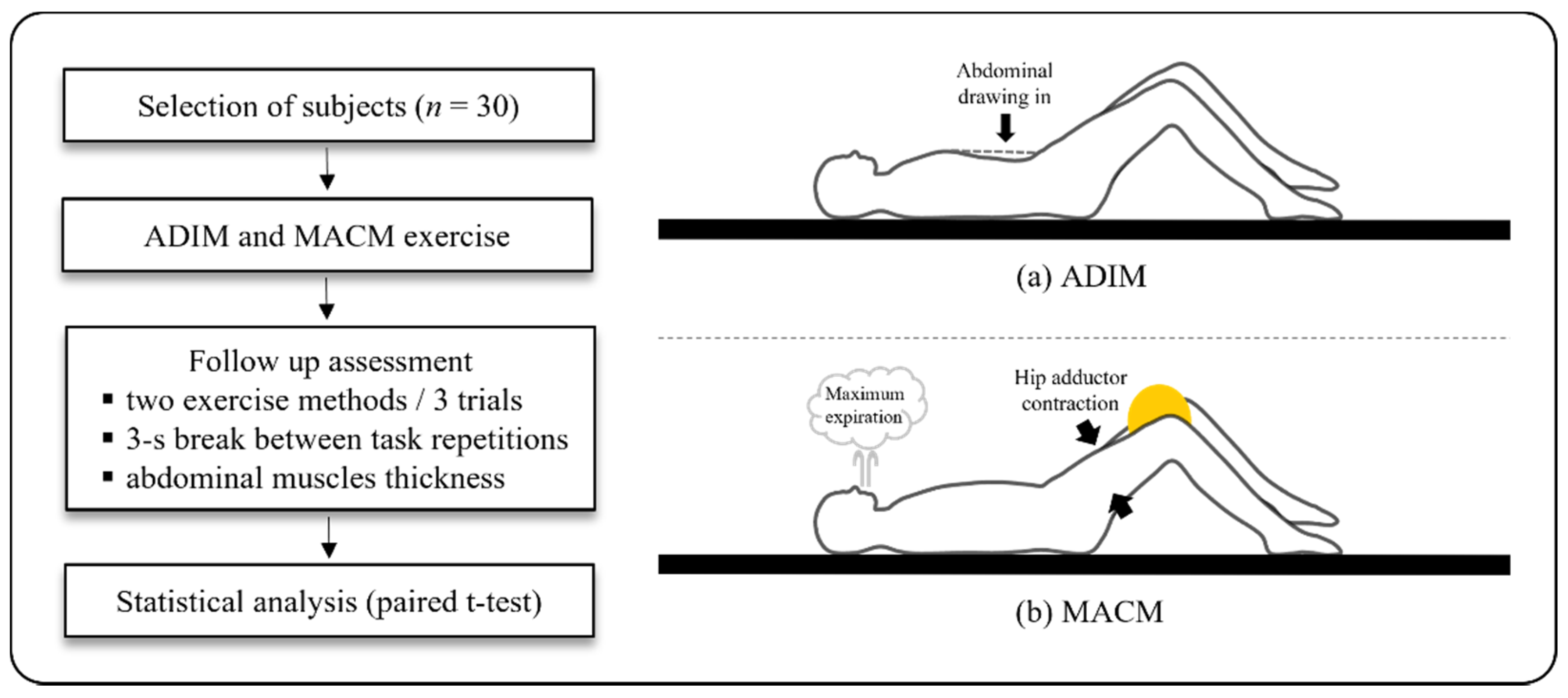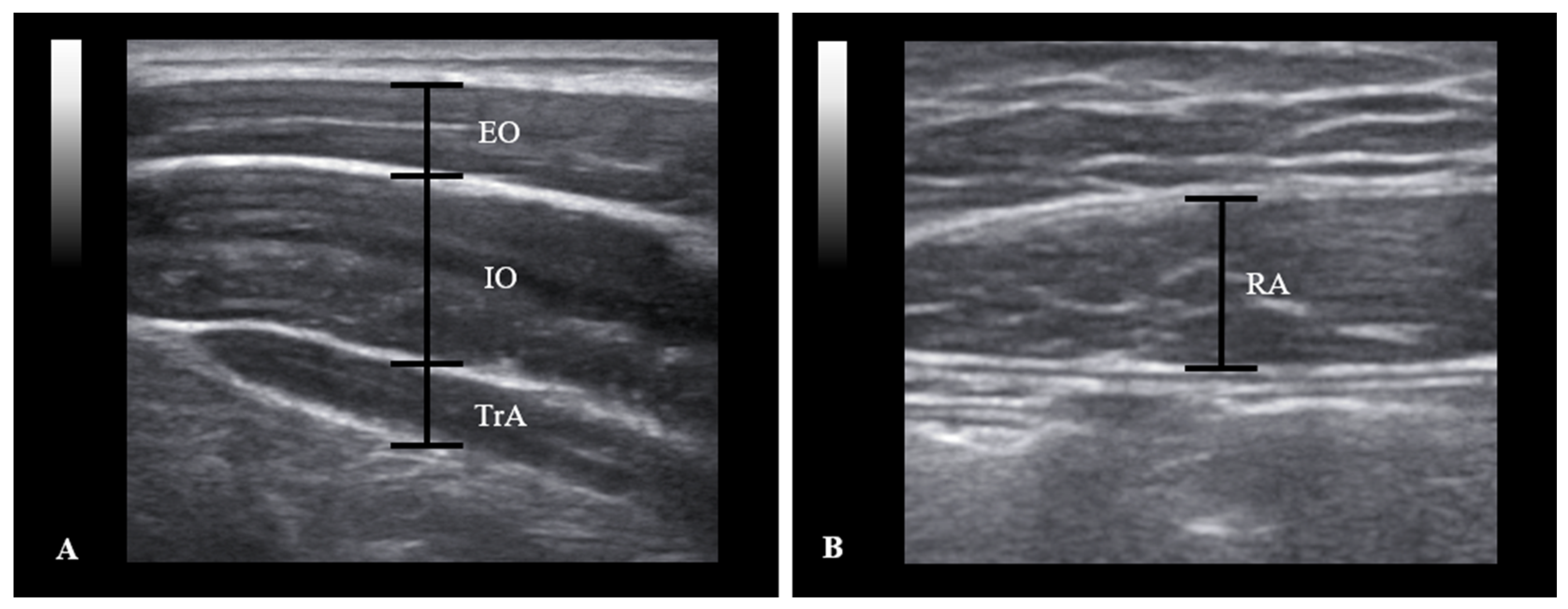Comparison of Abdominal Muscle Thickness between the Abdominal Draw-in Maneuver and Maximum Abdominal Contraction Maneuver
Abstract
:1. Introduction
2. Methods
2.1. Participants
2.2. Materials
2.3. Procedure
2.4. Data Analysis
3. Results
4. Discussion
5. Conclusions
Author Contributions
Funding
Institutional Review Board Statement
Informed Consent Statement
Data Availability Statement
Conflicts of Interest
References
- Gringmuth, R.H.; Jackson, C. Therapeutic exercise for spinal segmental stabilization in low back pain: Scientific basis and clinical approach. J. Can. Chiropr. Assoc. 2000, 44, 125. [Google Scholar]
- Arnold, C.; Lanovaz, J.; Oates, A.; Craven, B.; Butcher, S. The effect of adding core stability training to a standard balance exercise program on sit to stand performance in older adults: A pilot study. J. Aging Phys. Act. 2015, 23, 95–102. [Google Scholar] [CrossRef] [PubMed]
- McGill, S.M.; Grenier, S.; Kavcic, N.; Cholewicki, J. Coordination of muscle activity to assure stability of the lumbar spine. J. Electromyogr. Kinesiol. 2003, 13, 353–359. [Google Scholar] [CrossRef]
- Ishida, H.; Watanabe, S. Maximum expiration activates the abdominal muscles during side bridge exercise. J. Back Musculoskelet. Rehabil. 2015, 28, 81–84. [Google Scholar] [CrossRef]
- Ehsani, F.; Arab, A.M.; Assadi, H.; Karimi, N.; Shanbehzadeh, S. Evaluation of pelvic floor muscles activity with and without abdominal maneuvers in subjects with and without low back pain. J. Back Musculoskelet. Rehabil. 2016, 29, 241–247. [Google Scholar] [CrossRef] [PubMed] [Green Version]
- Massé-Alarie, H.; Beaulieu, L.-D.; Preuss, R.; Schneider, C. Task-specificity of bilateral anticipatory activation of the deep abdominal muscles in healthy and chronic low back pain populations. Gait Posture 2015, 41, 440–447. [Google Scholar] [CrossRef]
- Kim, J.-S.; Seok, C.-H.; Jeon, H.-S. Abdominal draw-in maneuver combined with simulated weight bearing increases transversus abdominis and internal oblique thickness. Physiother. Theory Pract. 2017, 33, 954–958. [Google Scholar] [CrossRef]
- Akuthota, V.; Nadler, S.F. Core strengthening. Arch. Phys. Med. Rehabil. 2004, 85, 86–92. [Google Scholar] [CrossRef]
- Jain, P.S.; Bathia, K.; Kanse-patil, S.; Patel, G.; Deshpande, V.J. Effectiveness of Swiss ball Exercises and Mini Stability ball Exercises on core Strength, Endurance and Dynamic balance in Mechanical Low back Pain. Scopus Ijphrd Cit. Score 2019, 10, 64–69. [Google Scholar] [CrossRef]
- Marshall, P.W.; Murphy, B.A. Core stability exercises on and off a Swiss ball. Arch. Phys. Med. Rehabil. 2005, 86, 242–249. [Google Scholar] [CrossRef]
- Kaping, K.; Äng, B.O.; Rasmussen-Barr, E. The abdominal drawing-in manoeuvre for detecting activity in the deep abdominal muscles: Is this clinical tool reliable and valid? BMJ Open 2015, 5, e008711. [Google Scholar] [CrossRef] [PubMed] [Green Version]
- Hides, J.; Wilson, S.; Stanton, W.; McMahon, S.; Keto, H.; McMahon, K.; Bryant, M.; Richardson, C. An MRI investigation into the function of the transversus abdominis muscle during “drawing-in” of the abdominal wall. Spine 2006, 31, E175–E178. [Google Scholar] [CrossRef] [PubMed]
- Abuín-Porras, V.; de la Cueva-Reguera, M.; Benavides-Morales, P.; Ávila-Pérez, R.; de la Cruz-Torres, B.; Pareja-Galeano, H.; Blanco-Morales, M.; Romero-Morales, C.J.M. Comparison of the Abdominal Wall Muscle Thickness in Female Rugby Players Versus Non-Athletic Women: A Cross-Sectional Study. Medicina 2020, 56, 8. [Google Scholar] [CrossRef] [PubMed] [Green Version]
- Abuín-Porras, V.; Maldonado-Tello, P.; de la Cueva-Reguera, M.; Rodríguez-Sanz, D.; Calvo-Lobo, C.; López-López, D.; Navarro-Flores, E.; Romero-Morales, C.J.M. Comparison of Lateral Abdominal Musculature Activation during Expiration with an Expiratory Flow Control Device Versus the Abdominal Drawing-in Maneuver in Healthy Women: A Cross-Sectional Observational Pilot Study. Medicina 2020, 56, 84. [Google Scholar] [CrossRef] [Green Version]
- Sharma, V.; Kaur, J. Effect of core strengthening with pelvic proprioceptive neuromuscular facilitation on trunk, balance, gait, and function in chronic stroke. J. Exerc. Rehabil. 2017, 13, 200. [Google Scholar] [CrossRef] [Green Version]
- Arab, A.M.; Chehrehrazi, M. The response of the abdominal muscles to pelvic floor muscle contraction in women with and without stress urinary incontinence using ultrasound imaging. Neurourol. Urodyn. 2011, 30, 117–120. [Google Scholar] [CrossRef]
- Talasz, H.; Kofler, M.; Kalchschmid, E.; Pretterklieber, M.; Lechleitner, M. Breathing with the pelvic floor? Correlation of pelvic floor muscle function and expiratory flows in healthy young nulliparous women. Int. Urogynecology J. 2010, 21, 475–481. [Google Scholar] [CrossRef]
- Ishida, H.; Hirose, R.; Watanabe, S. Comparison of changes in the contraction of the lateral abdominal muscles between the abdominal drawing-in maneuver and breathe held at the maximum expiratory level. Man. Ther. 2012, 17, 427–431. [Google Scholar] [CrossRef]
- Kwon, J.W.; Park, S.Y.; Baek, K.H.; Youk, K.; Oh, S.J.M. Breathing Exercise Called the Maximal Abdominal Contraction Maneuver. Medicina 2021, 57, 129. [Google Scholar] [CrossRef]
- Ishida, H.; Watanabe, S. Changes in lateral abdominal muscles’ thickness immediately after the abdominal drawing-in maneuver and maximum expiration. J. Bodyw. Mov. Ther. 2013, 17, 254–258. [Google Scholar] [CrossRef] [Green Version]
- Abe, T.; Kusuhara, N.; Yoshimura, N.; Tomita, T.; Easton, P.A. Differential respiratory activity of four abdominal muscles in humans. J. Appl. Physiol. 1996, 80, 1379–1389. [Google Scholar] [CrossRef] [PubMed]
- Kibler, W.B.; Press, J.; Sciascia, A. The role of core stability in athletic function. Sports Med. 2006, 36, 189–198. [Google Scholar] [CrossRef] [PubMed]
- Matthijs, O.C.; Dedrick, G.S.; James, C.R.; Brismée, J.-M.; Hooper, T.L.; McGalliard, M.K.; Sizer, P.S., Jr. Co-contractive activation of the superficial multifidus during volitional preemptive abdominal contraction. PMR 2014, 6, 13–21. [Google Scholar] [CrossRef]
- Cartwright, M.S.; Demar, S.; Griffin, L.P.; Balakrishnan, N.; Harris, J.M.; Walker, F.O.J. Validity and reliability of nerve and muscle ultrasound. Muscle Nerve 2013, 47, 515–521. [Google Scholar] [CrossRef] [PubMed]
- Borna, S.; Noormohammadpour, P.; Linek, P.; Mansournia, M.A.; Kordi, R. Ultrasound measurements of the lateral abdominal muscle thicknesses in girls with adolescent idiopathic scoliosis. Asian J. Sports Med. 2017, 8, e32274. [Google Scholar] [CrossRef]
- Nakai, Y.; Kawada, M.; Miyazaki, T.; Kiyama, R. Trunk muscle activity during trunk stabilizing exercise with isometric hip rotation using electromyography and ultrasound. J. Electromyogr. Kinesiol. 2019, 49, 102357. [Google Scholar] [CrossRef]
- Ofri, A.; Schindler, T.; Dilley, A.; Pereira, J.; Adams, S. Defining normal neonatal abdominal wall musculature with ultrasonography. J. Pediatric Surg. 2018, 53, 1588–1591. [Google Scholar] [CrossRef]
- Grooms, D.R.; Grindstaff, T.L.; Croy, T.; Hart, J.M.; Saliba, S.A. Clinimetric analysis of pressure biofeedback and transversus abdominis function in individuals with stabilization classification low back pain. J. Orthop. Sports Phys. Ther. 2013, 43, 184–193. [Google Scholar] [CrossRef] [Green Version]
- Richardson, C.A.; Snijders, C.J.; Hides, J.A.; Damen, L.; Pas, M.S.; Storm, J. The relation between the transversus abdominis muscles, sacroiliac joint mechanics, and low back pain. Spine 2002, 27, 399–405. [Google Scholar] [CrossRef]
- Park, J.-Y.; Cho, J.-H.; Yu, J.-H.; Hong, J.-H.; Lee, D.-Y.; Kim, J.-S. Effects of Maximal Expiratory Resistance Training on lateral Abdominal Muscles in Normal Adults. Res. J. Pharm. Technol. 2017, 10, 2717–2722. [Google Scholar] [CrossRef]
- Cohen, J. Statistical Power Analysis for the Behavioral Sciences; Academic Press: New York, NY, USA, 2013. [Google Scholar]
- Chon, S.-C.; Chang, K.-Y.; You, J.S.H. Effect of the abdominal draw-in manoeuvre in combination with ankle dorsiflexion in strengthening the transverse abdominal muscle in healthy young adults: A preliminary, randomised, controlled study. Physiotherapy 2010, 96, 130–136. [Google Scholar] [CrossRef] [PubMed]
- Tayashiki, K.; Maeo, S.; Usui, S.; Miyamoto, N.; Kanehisa, H. Effect of abdominal bracing training on strength and power of trunk and lower limb muscles. Eur. J. Appl. Physiol. 2016, 116, 1703–1713. [Google Scholar] [CrossRef] [PubMed]
- Malanga, G.A.; Aydin, S.M.; Holder, E.K.; Petrin, Z. Functional therapeutic and core strengthening. In The Hip and Pelvis in Sports Medicine and Primary Care; Springer: Berlin/Heidelberg, Germany, 2017; pp. 185–214. [Google Scholar]
- Neumann, P.; Gill, V. Pelvic floor and abdominal muscle interaction: EMG activity and intra-abdominal pressure. Int. Urogynecology J. 2002, 13, 125–132. [Google Scholar] [CrossRef] [PubMed]
- Jang, E.-M.; Kim, M.-H.; Oh, J.-S. Effects of a bridging exercise with hip adduction on the EMG activities of the abdominal and hip extensor muscles in females. J. Phys. Ther. Sci. 2013, 25, 1147–1149. [Google Scholar] [CrossRef] [PubMed] [Green Version]
- Zachovajeviene, B.; Siupsinskas, L.; Zachovajevas, P.; Venclovas, Z.; Milonas, D. Effect of diaphragm and abdominal muscle training on pelvic floor strength and endurance: Results of a prospective randomized trial. Sci. Rep. 2019, 9, 19192. [Google Scholar] [CrossRef]



| Sex | Number of Subjects | Age | Height (cm) | Weight (kg) | Body Mass Index (kg/m2) |
|---|---|---|---|---|---|
| Male | 17 | 23.71 (1.65) | 173.18 (6.10) | 72.71 (12.89) | 24.17 (3.54) |
| Female | 13 | 22.15 (1.46) | 162.08 (5.42) | 56.45 (7.87) | 21.49 (2.91) |
| Muscles | ADIM | MACM | p | ES (95% CI) |
|---|---|---|---|---|
| TrA (cm) | 0.22 (0.14) | 0.36 (0.16) | <0.001 * | 0.931 (0.178 to 1.685) |
| IO (cm) | 0.24 (0.20) | 0.40 (0.22) | 0.001 * | 0.761 (0.02 to 1.502) |
| EO (cm) | 0.05 (0.13) | 0.12 (0.20) | 0.008 * | 0.415 (−0.308 to 1.138) |
| RA (cm) | 0.03 (0.12) | 0.13 (0.14) | <0.001 * | 0.767 (0.025 to 1.509) |
Publisher’s Note: MDPI stays neutral with regard to jurisdictional claims in published maps and institutional affiliations. |
© 2022 by the authors. Licensee MDPI, Basel, Switzerland. This article is an open access article distributed under the terms and conditions of the Creative Commons Attribution (CC BY) license (https://creativecommons.org/licenses/by/4.0/).
Share and Cite
Park, S.-Y.; Oh, S.; Baek, K.-H.; Bae, S.-S.; Kwon, J.-W. Comparison of Abdominal Muscle Thickness between the Abdominal Draw-in Maneuver and Maximum Abdominal Contraction Maneuver. Healthcare 2022, 10, 251. https://doi.org/10.3390/healthcare10020251
Park S-Y, Oh S, Baek K-H, Bae S-S, Kwon J-W. Comparison of Abdominal Muscle Thickness between the Abdominal Draw-in Maneuver and Maximum Abdominal Contraction Maneuver. Healthcare. 2022; 10(2):251. https://doi.org/10.3390/healthcare10020251
Chicago/Turabian StylePark, Seo-Yoon, Seunghue Oh, Ki-Hyun Baek, Sung-Soo Bae, and Jung-Won Kwon. 2022. "Comparison of Abdominal Muscle Thickness between the Abdominal Draw-in Maneuver and Maximum Abdominal Contraction Maneuver" Healthcare 10, no. 2: 251. https://doi.org/10.3390/healthcare10020251
APA StylePark, S.-Y., Oh, S., Baek, K.-H., Bae, S.-S., & Kwon, J.-W. (2022). Comparison of Abdominal Muscle Thickness between the Abdominal Draw-in Maneuver and Maximum Abdominal Contraction Maneuver. Healthcare, 10(2), 251. https://doi.org/10.3390/healthcare10020251






